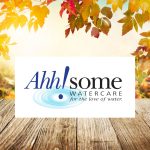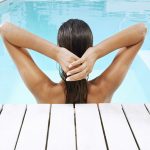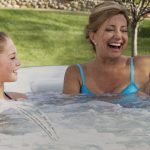Many people exaggerate the difficulty in maintaining their swimming pool and hot tub water. Actually, it can be quite simple and you DO NOT need a chemistry degree to do a great job. Recreational Water can mean great times for family and friends when it is crystal clear, algae free and inviting. However, there are numerous facets to recreational water maintenance that can trigger varying responses on your part in an effort to maintain that perfect balance. Let’s begin with the basics:
Testing-Testing-Testing: We strongly recommend NOT USING a “DIP STRIP” type of water test kit. Many factors too numerous to mention can interfere dramatically with the accuracy of your tests. These inexpensive test strips are ok for a rough estimate, but don’t bet the farm on their accuracy. Invest in a good quality “Drop” or Titration test kit. A few main brands are Taylor K-2006 and LaMotte. There are many more that are no doubt private labeled and are just as good. The test kit available at Trouble Free Pool.com, a Q & A forum for pool and hot tub owners, also has a great kit with all the necessary test capabilities. Be sure to always replace the “reagents, the little bottles in the test kit, annually, since the shelf life is about 1 year. Keep the kit in a cool place out of the sun. Ideally, test in the A.M. before swimmer or bather activity.

pH: Mother nature has built-in a perfect ratio of acid/base levels that recreational water tends to be always seeking for optimum chemical performance and bather comfort. The pH scale goes from a very acidic0.0 to a very basic 14.0. Ideally, pool and hot tub/swim spa water should be maintained at a level between 7.2-7.8 with 7.5 being absolutely spot on. At these levels, sanitizers work very well and give you the most bang for the buck. Volumes have been written about pH but we are not working in a nuclear chemical lab. We just need to know the basic basics. At a pH in the proper range the water will feel great. As the pH goes low your water can become hazy and you’ll need to use additional sanitizer to do the same job that an “in balance” pH did. You increase the pH by adding “sodium carbonate”, an inexpensive chemical that you can readily find. To decrease the pH, you add either a dry acid, “sodium bi-sulphate, or “muriatic acid”. Adjusting the pHdown should be performed by adding small amounts at a time and not doing it all at once. Adding an extraordinary of pH decreased at one time may affect or lower your total alkalinity (TA). You can raise the pH all at once with no issues. Note: A lower pH (high acid content) can be detrimental to all metal components where the water touches. Very lowpH for extended times is not a good thing. A very high pH can also affect components and cause issues. High pH will usually make the water cloudy and turbid. Just keep the water in pH balance and the majority of the water issues will not come into play. One note: In hot tubs, when you run the jets and add ambient air into the tub in an effort to gain turbulence and higher jet pressure, the pH will usually rise a little. If the water is “in balance”, the pH will typically come down to the ideal range after a few hours after your soaking experience.
TA: This is called Total Alkalinity (TA). Alkalinity is a buffer. This is a measurement of the carbonates and bicarbonates and hydroxides in the water. A high (TA), over 120 or so, means that additions of acid to lower pH will need to be increased to actually lower it. You can use a pH decreaser, (muriatic acid or sodium bi-sulphate) to lower (TA). High TA requires a lower pH to have balanced water. Low (TA) means that the water pH will usually err on the lower side. Low (TA) means the pH has to be higher to have balanced water. You can raise (TA) by adding baking soda, which is sodium bicarbonate. pH and TA are kissing cousins, but not the same thing. Ideally, in swimming pools the recommended (TA)is 80-120 ppm (part per million). In hot tubs, because of the greater amounts of aeration and warmer water we usually recommend keeping (TA)around 40-60 ppm. Bottom line is this: Getting the (TA) calibrated at the beginning is generally all you will need unless large amounts of water are added to the pool or the hot tub is drained periodically. Depending on the chemical additions over time the total alkalinity should not make drastic swings.
CH: Calcium Hardness is essentially the amount of calcium in your water. High calcium levels, generally over 250 ppm, will mean that your water is considered “harder than normal”. A good (CH) level is around150-200 ppm. The important thing to remember is that the lower your (CH), the higher you will need to keep your (TA) and (pH), in order to have balanced water. Conversely, the higher the (CH) level means that your (TA) and (pH) need to be adjusted slightly lower to attain balanced water. You increase the (CH) by adding calcium chloride. You lower the calcium level by draining some of the water and using softer water to refill. You can also reduce (CH) by adding a flocculant to the water, typically aluminum sulphate (floc). This precipitates some of the calcium and you vacuum it out of the vessel after it settles to the bottom. This is a “last resort” type of thing IMHO. You need to vacuum very slowly to waste so it is eliminated. Easier to accomplish in pools rather than hot tubs or swim spas. NOTE: Your test kit instructions should delineate what amounts to add for pH, TA or CH adjustments you will need to make balanced water.
Sanitizers: The typical sanitizer used in swimming pools and hot tubs is Chlorine.
Chlorine is an EPA registered product that kills bacteria, algae and a plethora of pathogens introduced by the bathers or from natural phenomena. There are many different types of chlorine delivery products. Some are granular, tablet, liquid or “on-site” systems called saltwater generators (SWG). Depending on whether you have a swimming pool, hot tub or swim spa will typically determine the best way to chlorinate. Chlorine types are the following. Cal Hypo (calcium hypochlorite), a granular or tablet that is used for swimming pools.Bleach (sodium hypochlorite), which is used as a shock treatment or can be used as maintenance chlorine by itself. Di-Chlor ( Dichloro STriazinetrione), typically a granular product primarily used for hot tubs and swim spas. Tri-Chlor (Trichloro-S Triazinetrione) typically one inch or 3-inch tablet used primarily in swimming pools or commercial in-ground hot tubs. Salt Water Chlorine Generators manufacture chlorine on-site which reduces quite a bit of maintenance for the pool or hot tub owner. The above is not the complete list of types of chlorine available but will be the primary types that are readily available for consumers to use in their swimming pools, hot tubs, or swim spas. Your pool or hot tub retailer can go over the types they recommend you to use. Be sure to discuss water chemistry at length with a professionally trained associate. The typical Hot Tub or Swim Spa will use Di-Chlorchlorine with periodic super chlorination to eliminate bacteria and other nasties that may be accumulating. The typical swimming pool will use Tri-Chlor 3″ chlorine tablets in a feeder, (strongly recommended), and periodic shocking or super chlorination using Cal Hypo granular or liquid Chlorine on a regular basis.
Bromine is another sanitizer that is primarily used in hot tubs and swim spas. Bromine dissipates less in high water temperatures, is more effective as a sanitizer at higher or lower pH ranges, and is less reactive than chlorine so it may be easier on your skin. Note: When using bromine your chlorine test kit will not give you accurate readings on sanitizer levels. You will need a test kit that is used for bromine. The test kit I recommend is Taylor 2106. Bromine is very popular for hot water vessels such as hot tubs and swim spas. Some pools use bromine but its use is very minimal since sunlight can dissipate it rapidly and wind up costing you much more to maintain adequate sanitizer levels. Bromine can be a 2 step or 3 step program. A 2 step program is where you initially add sodium bromide to a required level and then add your typical oxidizer, usually Chlorine or a Non-Chlorine shock called MPS to activate the bromide ions into active sanitizer. The 3 step program is like the 2 step except that you also have a floater in the pool or hot tub that has bromine tablets in it. This 3 step program makes for a more constant bromine level. Here’s what you do to start a hot tub or swim spa on Bromine. Add sodium bromide as a reserve or bank to approximately 12-15 ppm. Then, add oxidizer such as chlorine or MPSshock treatment to establish a bromine residual of 3-4 ppm. Be sure to use a test kit made for bromine readings as a chlorine residual test kit will not work. Bromine is more popular in hot tubs and swim spas than chlorine. Do not use Bromine as a sanitizer if you are using an Ozonator in your vessel. This is NOT RECOMMENDED due to a possible increased formation of bromates. bromates are considered a carcinogen.

Salt Water Generators (SWG): The use of SWG’s has increased dramatically over the last 15 years. SWG’s were invented and used in Australia long before the USA caught on. Essentially, these are devices that manufacture what is called “free chlorine”, “on-site”. This is a wonderful way to sanitize because it requires drastically less maintenance on your part. You simply add the correct amount of salt “sodium chloride” into the pool or hot tub to reach a minimum level whereby the generator can manufacture the main killing ingredient in chlorine, hypochlorous acid, by separating the salt molecule to generate chlorine via a process called electrolysis. The amount of salt added to the pool or tub is barely noticeable to most swimmers and bathers. The salt cell that does the electrolysis needs periodic cleanings and will require replacement after so many hours of usage. You turn it up for more generation anddown for less. Your TEST KIT Readings will determine where you need toset it. Talk to your pool or hot tub retailer about the benefits of this type of sanitizer system. Remember, you are still swimming and soaking in water disinfected by chlorine, albeit, this method is more soothing and less caustic than the regular use of chlorine products in most cases.

Ozone Generators: Ozone is what I call “excited oxygen”. Ozone generators are extremely popular for Hot Tubs & Swim Spas and do play a smaller role in swimming pool disinfection. Ozone is generally used in conjunction with your regular sanitizer to work synergistically with it. You would never just need an Ozonator to maintain a pool or spa without using a main sanitizer like chlorine or bromine. Ozone can help you reduce the amount of sanitizer necessary to maintain a healthy hot tub or swimming pool. Ozone gas is much stronger oxidizer than chlorine or bromine and it works faster without leaving chemical byproducts of chlorination and bromination. However, Ozone is not typically a “standalone” sanitizer for a variety of reasons, namely, it doesn’t residualize like chlorine or bromine. In other words, you can generate the ozone gas and let it build up until it is needed. Once itis generated it oxidizes whatever it touches in the water and dissipates. Ozone gas is generated by UV light units or corona discharge, a stronger and more powerful generator. What I like about ozone is that it helps to break up combined chlorine and bromine molecules that have bonded to contaminants. Breaking these up lets the chlorine or bromine to get back to work at disinfecting and sanitizing. Ozone generators are fairly inexpensive to install and usually come with newer style hot tubs from the factory. Remember, even though you have an Ozonator does not mean that you don’t need chlorine or bromine.

What about Enzymes: Enzymes are gaining in popularity for usage in hot tubs and swimming pools. Enzymes are proteins that work in conjunction with your everyday sanitizer to synergistically allow your sanitizer to work better. Typically, enzymes are designed to rid your spa or pool of oils and grease that forms scum lines around the perimeter. Enzymesdeploy a positive charge and bind especially well with body fluids and other materials that are filtered out allowing your water to remain”foam free” and clear for longer periods of time. In hot tubs this can be a godsend since you won’t be dumping the water as frequently. one caveat: There are good enzymes and not so good enzymes. This area has many companies that may make outrageous claims regarding what you can expect after adding them to your pool or hot tub. Enzymes are catalysts. A catalyst is something that causes or accelerates a chemical reaction. Enzymes for recreational water are biological and not chemical in origin. They are made to perform specific functions, typically, to break down and reduce body oils and scum contaminants. There is a place for good enzymes that are proven to work. Read reviews before you buy just any brand you see. We speak with hot tub owners who try to use just enzymes and no other sanitizer in their water. This is a recipe for disaster and you may get very sick. Don’t believe all the hype about enzymes as a water treatment. They serve a purpose and some really work. However, you still need a sanitizer to oxidize organic bather wastes and a plethora of other detritus gunk that can find it’sway into your little oasis and getaway vessel. Don’t take a chance without using an EPA registered sanitizer.
THE BOTTOM LINE IS THIS:
Unique Solutions is a company that really is committed to help you navigate through all the maintenance and sanitizer parlance that you may find overwhelming. We ask that you simply call us or email us to discuss your issues. You will be speaking with an individual who will give you the honest to goodness advice that you deserve. We do not sell all these chemicals but with over 50 years of water chemistry issues, we’ve heard and seen it all. You would not be bothering us to ask questions. We won’t be trying to sell you anything. Our product category is not very broad in scope as we are typically a one-trick pony. We aid in the removal of biofilm in recreational water vessels. Biofilm is usually the culprit behind many of the water care and maintenance issues you will be trying to eliminate. Let us assist you! You can call us 7 days a week and we promise to take the call or get back to you in a timely manner. Call us at 860-896-0836. This is only a shortened version of the many products that are used for swimming pools and hot tubs to aid in their maintenance. There are more and we can discuss them on a one-on-one basis if need be. Textbooks have been written about water care. The information presented here is the real skinny on a short version.











